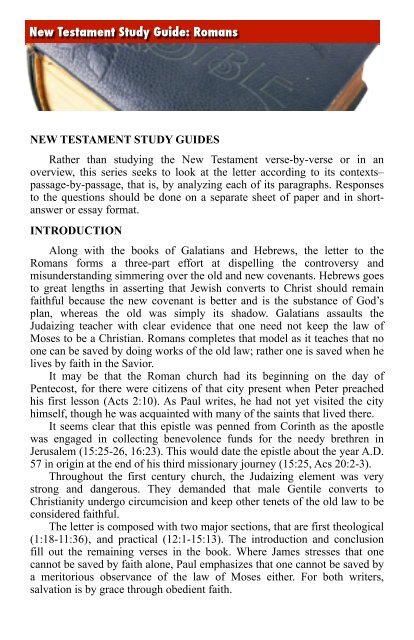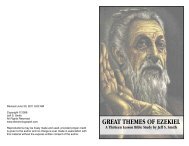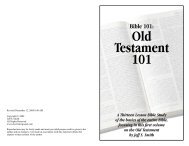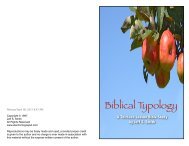New Testament Study Guides - ElectronicGospel
New Testament Study Guides - ElectronicGospel
New Testament Study Guides - ElectronicGospel
You also want an ePaper? Increase the reach of your titles
YUMPU automatically turns print PDFs into web optimized ePapers that Google loves.
<strong>New</strong> <strong>Testament</strong> <strong>Study</strong> Guide: Romans<br />
NEW TESTAMENT STUDY GUIDES<br />
Rather than studying the <strong>New</strong> <strong>Testament</strong> verse-by-verse or in an<br />
overview, this series seeks to look at the letter according to its contexts–<br />
passage-by-passage, that is, by analyzing each of its paragraphs. Responses<br />
to the questions should be done on a separate sheet of paper and in shortanswer<br />
or essay format.<br />
INTRODUCTION<br />
Along with the books of Galatians and Hebrews, the letter to the<br />
Romans forms a three-part effort at dispelling the controversy and<br />
misunderstanding simmering over the old and new covenants. Hebrews goes<br />
to great lengths in asserting that Jewish converts to Christ should remain<br />
faithful because the new covenant is better and is the substance of God’s<br />
plan, whereas the old was simply its shadow. Galatians assaults the<br />
Judaizing teacher with clear evidence that one need not keep the law of<br />
Moses to be a Christian. Romans completes that model as it teaches that no<br />
one can be saved by doing works of the old law; rather one is saved when he<br />
lives by faith in the Savior.<br />
It may be that the Roman church had its beginning on the day of<br />
Pentecost, for there were citizens of that city present when Peter preached<br />
his first lesson (Acts 2:10). As Paul writes, he had not yet visited the city<br />
himself, though he was acquainted with many of the saints that lived there.<br />
It seems clear that this epistle was penned from Corinth as the apostle<br />
was engaged in collecting benevolence funds for the needy brethren in<br />
Jerusalem (15:25-26, 16:23). This would date the epistle about the year A.D.<br />
57 in origin at the end of his third missionary journey (15:25, Acs 20:2-3).<br />
Throughout the first century church, the Judaizing element was very<br />
strong and dangerous. They demanded that male Gentile converts to<br />
Christianity undergo circumcision and keep other tenets of the old law to be<br />
considered faithful.<br />
The letter is composed with two major sections, that are first theological<br />
(1:18-11:36)‚ and practical (12:1-15:13). The introduction and conclusion<br />
fill out the remaining verses in the book. Where James stresses that one<br />
cannot be saved by faith alone, Paul emphasizes that one cannot be saved by<br />
a meritorious observance of the law of Moses either. For both writers,<br />
salvation is by grace through obedient faith.









